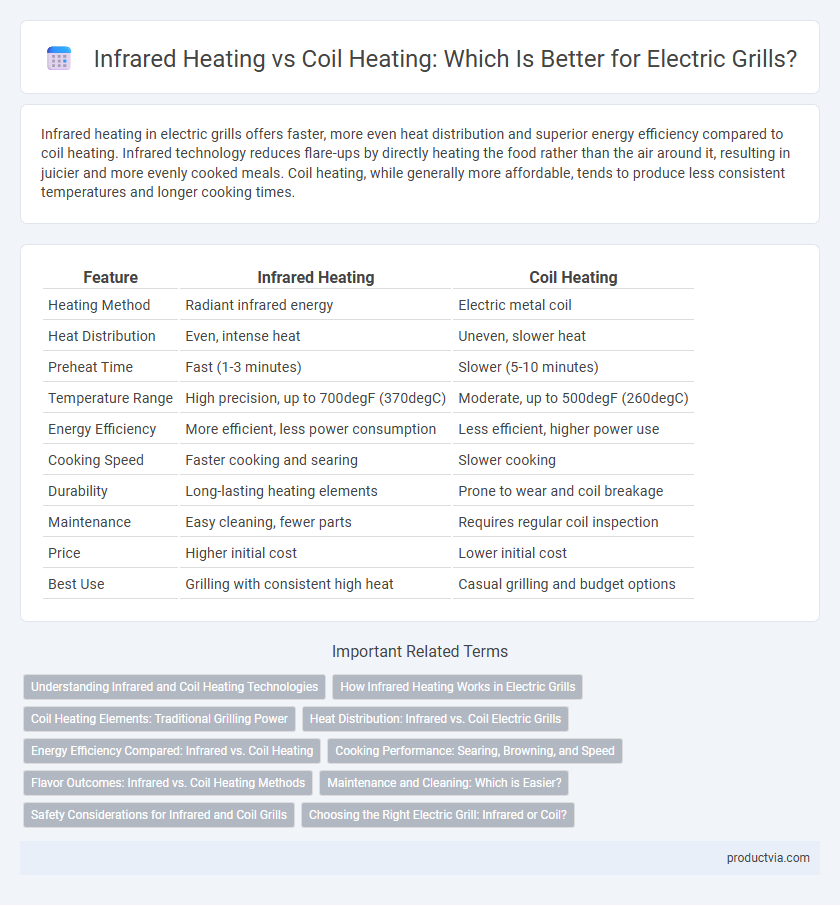Infrared heating in electric grills offers faster, more even heat distribution and superior energy efficiency compared to coil heating. Infrared technology reduces flare-ups by directly heating the food rather than the air around it, resulting in juicier and more evenly cooked meals. Coil heating, while generally more affordable, tends to produce less consistent temperatures and longer cooking times.
Table of Comparison
| Feature | Infrared Heating | Coil Heating |
|---|---|---|
| Heating Method | Radiant infrared energy | Electric metal coil |
| Heat Distribution | Even, intense heat | Uneven, slower heat |
| Preheat Time | Fast (1-3 minutes) | Slower (5-10 minutes) |
| Temperature Range | High precision, up to 700degF (370degC) | Moderate, up to 500degF (260degC) |
| Energy Efficiency | More efficient, less power consumption | Less efficient, higher power use |
| Cooking Speed | Faster cooking and searing | Slower cooking |
| Durability | Long-lasting heating elements | Prone to wear and coil breakage |
| Maintenance | Easy cleaning, fewer parts | Requires regular coil inspection |
| Price | Higher initial cost | Lower initial cost |
| Best Use | Grilling with consistent high heat | Casual grilling and budget options |
Understanding Infrared and Coil Heating Technologies
Infrared heating technology in electric grills uses radiant heat to directly warm food, offering faster cooking times and even heat distribution, which reduces flare-ups and retains moisture better. Coil heating elements provide a traditional method by heating metal coils that transfer heat through direct contact and convection, resulting in slower but more even heat suitable for various cooking styles. Infrared grills excel in searing and high-temperature grilling due to their intense, focused heat, while coil heaters offer versatility and consistent medium-range temperatures for diverse grilling needs.
How Infrared Heating Works in Electric Grills
Infrared heating in electric grills works by emitting infrared radiation that directly heats the food without warming the surrounding air, resulting in faster cooking and even heat distribution. This method uses a ceramic or metal emitter that absorbs electrical energy and converts it into infrared waves, which penetrate the food's surface to lock in moisture and enhance flavor. Infrared electric grills typically reach higher temperatures efficiently compared to traditional coil heating elements, making them ideal for searing and achieving restaurant-quality grilling results.
Coil Heating Elements: Traditional Grilling Power
Coil heating elements in electric grills provide consistent and even heat distribution, making them ideal for traditional grilling techniques. These elements offer reliable temperature control and are known for their durability and affordability compared to infrared options. Coil heating maintains a steady cooking surface, perfect for searing and achieving classic grill marks.
Heat Distribution: Infrared vs. Coil Electric Grills
Infrared electric grills utilize radiant heat that penetrates food evenly, ensuring consistent cooking temperature across the cooking surface. Coil electric grills rely on direct contact with the heating element, often causing uneven heat distribution and hot spots. Infrared technology offers superior heat retention and more uniform heat dispersion compared to traditional coil elements, enhancing grill performance.
Energy Efficiency Compared: Infrared vs. Coil Heating
Infrared heating in electric grills delivers faster heat-up times and more direct heat transfer, resulting in higher energy efficiency compared to coil heating. Coil heating elements consume more electricity due to slower heat distribution and greater heat loss to the surrounding air. Choosing an infrared electric grill can reduce energy consumption by up to 30%, making it a more eco-friendly and cost-effective option.
Cooking Performance: Searing, Browning, and Speed
Infrared heating in electric grills delivers intense, focused heat that enhances searing and browning by quickly reaching high temperatures, locking in juices and flavors for superior cooking performance. Coil heating systems provide more even heat distribution but typically take longer to achieve the same level of browning and searing intensity, resulting in slower overall cooking times. Choosing infrared heating optimizes speed and ensures enhanced caramelization and crust formation, making it ideal for high-performance grilling.
Flavor Outcomes: Infrared vs. Coil Heating Methods
Infrared heating in electric grills delivers intense, radiant heat that sears meat quickly, locking in natural juices and enhancing flavor through caramelization and Maillard reactions. Coil heating provides more uniform, moderate heat that cooks food evenly but lacks the high-temperature searing effect needed for rich, smoky flavor development. Choosing infrared heating optimizes flavor outcomes by producing a crisp exterior and juicy interior, while coil heating ensures consistent doneness with milder taste profiles.
Maintenance and Cleaning: Which is Easier?
Infrared heating elements in electric grills typically have a sealed design that resists grease buildup, making maintenance and cleaning faster and less frequent. Coil heating elements are exposed and accumulate food particles and grease, requiring regular scrubbing to prevent residue buildup and potential corrosion. The sealed nature of infrared systems generally results in a longer lifespan and less intensive cleaning compared to coil heating setups.
Safety Considerations for Infrared and Coil Grills
Infrared electric grills use radiant heat that reduces flare-ups and minimizes the risk of burns, enhancing safety during cooking. Coil heating elements operate at lower temperatures but can cause uneven heating spots and increased flare-up potential, requiring careful monitoring. Infrared grills often feature enclosed heating surfaces, limiting direct contact and reducing accidental burns compared to exposed coil elements.
Choosing the Right Electric Grill: Infrared or Coil?
Infrared heating in electric grills uses radiant energy to cook food quickly and evenly, retaining moisture and enhancing flavor with higher temperature precision compared to coil heating. Coil heating elements, while more common and generally affordable, provide slower heat distribution and may result in uneven cooking or flare-ups. Choosing between infrared and coil heating depends on your priority for speed, temperature control, and flavor intensity in grilling performance.
Infrared heating vs coil heating for electric grill Infographic

 productvia.com
productvia.com